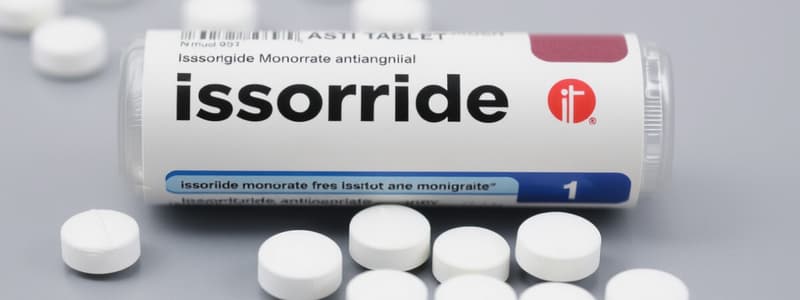Podcast
Questions and Answers
What is the classification of Isosorbide Mononitrate?
What is the classification of Isosorbide Mononitrate?
- Antianginal (correct)
- Antibiotic
- Diuretic
- Antihypertensive
Which of the following are trade names for Isosorbide Mononitrate? (Select all that apply)
Which of the following are trade names for Isosorbide Mononitrate? (Select all that apply)
- Imdur (correct)
- Ativan
- Monoket (correct)
- ISMO (correct)
What route is Isosorbide Mononitrate given?
What route is Isosorbide Mononitrate given?
PO
How frequently is Isosorbide Mononitrate taken?
How frequently is Isosorbide Mononitrate taken?
What is the onset time for Isosorbide Mononitrate?
What is the onset time for Isosorbide Mononitrate?
What is the peak effect of Isosorbide Mononitrate?
What is the peak effect of Isosorbide Mononitrate?
What is the duration of effect for Isosorbide Mononitrate?
What is the duration of effect for Isosorbide Mononitrate?
What is the dosage range for Isosorbide Mononitrate?
What is the dosage range for Isosorbide Mononitrate?
How does Isosorbide Mononitrate work in the body?
How does Isosorbide Mononitrate work in the body?
Does Isosorbide Mononitrate interact with other medications or supplements?
Does Isosorbide Mononitrate interact with other medications or supplements?
What vital sign parameter requires you to hold Isosorbide Mononitrate?
What vital sign parameter requires you to hold Isosorbide Mononitrate?
Why is the client taking Isosorbide Mononitrate?
Why is the client taking Isosorbide Mononitrate?
What is the therapeutic effect of Isosorbide Mononitrate?
What is the therapeutic effect of Isosorbide Mononitrate?
What assessment should be done before giving Isosorbide Mononitrate?
What assessment should be done before giving Isosorbide Mononitrate?
What ongoing assessments are needed while taking Isosorbide Mononitrate?
What ongoing assessments are needed while taking Isosorbide Mononitrate?
Stopping Isosorbide Mononitrate abruptly could cause increased ______ and risk for MI.
Stopping Isosorbide Mononitrate abruptly could cause increased ______ and risk for MI.
What is a key teaching point regarding the consumption of Isosorbide Mononitrate?
What is a key teaching point regarding the consumption of Isosorbide Mononitrate?
Match the following side/adverse effects with Isosorbide Mononitrate:
Match the following side/adverse effects with Isosorbide Mononitrate:
Study Notes
Classification
- Isosorbide mononitrate is classified as an antianginal medication.
Trade Names
- Common trade names include Monoket, ISMO, and Imdur.
Route of Administration
- Administered orally (PO).
Frequency of Dosing
- Taken twice daily (b.i.d) with doses spaced 7 hours apart.
Onset of Action
- Onset occurs within 30 to 45 minutes after administration.
Peak Effect
- The peak effect is currently unknown.
Duration of Action
- The duration of action ranges from 4 to 8 hours.
Dosage Range
- Typical dosages can range from 5 mg to 120 mg.
Mechanism of Action
- Relaxes blood vessels, increases oxygen supply to the heart, and reduces the workload on the heart.
Drug Interactions
- There are no known interactions with other medications or herbal/food supplements.
Vital Sign Monitoring
- Blood pressure should be monitored; withhold the medication if BP is 100/60 mmHg or lower.
Indication for Use
- Prescribed for clients with coronary artery disease, characterized by narrowed or blocked arteries causing chest pain.
Therapeutic Effects
- Aims to prevent and relieve episodes of chest pain (angina).
Pre-Administration Assessment
- Assess the location, duration, intensity, and triggers of anginal pain, listen for heart sounds, evaluate capillary refill, and measure blood pressure.
Ongoing Assessment
- Continuously monitor blood pressure, capillary refill, check for edema, and examine skin for unusual lesions.
Patient Education
- Advise against abrupt discontinuation, which can heighten angina and increase the risk of myocardial infarction (MI).
- Instruct to take the medication on an empty stomach to avoid reduced effectiveness.
Side and Adverse Effects
- Common side effects include headache, orthostatic hypotension, tachycardia, edema, nausea and vomiting, and rash.
Studying That Suits You
Use AI to generate personalized quizzes and flashcards to suit your learning preferences.
Description
This quiz features flashcards about isosorbide mononitrate, focusing on its classification, trade names, administration route, and other pharmacological details. Perfect for medical students or those studying pharmacology, the flashcards will help reinforce key concepts and definitions related to this antianginal medication.


